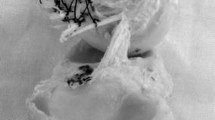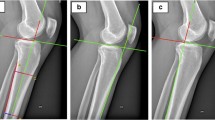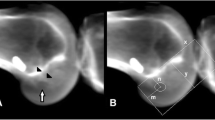Abstract
Purpose
The purpose of this study was to determine whether radiographic femoral bicondylar width predicts intra-operative anterior cruciate ligament (ACL) insertion site sizes.
Methods
Seventy-three consecutive patients (39 males and 34 females; mean age 25.2 years ± 10.2) who underwent anatomic ACL reconstruction were retrospectively reviewed. Femoral condyle width was measured using a pre-operative anteroposterior (AP) radiograph of the operative knee. Lines were drawn through the anatomic axis of the femur, as well as perpendicularly through the condyles. Bicondylar width was measured as the maximum width across both the medial and lateral femoral condyles utilizing this perpendicular line. The ACL insertion site lengths (in the AP direction) of both the tibia and the femur were measured intra-operatively using a commercially available arthroscopic ruler.
Results
The average bicondylar width was significantly smaller for females compared to males (p < 0.05). The average tibial and femoral insertion site sizes were significantly smaller for females compared to males (p < 0.05). Regression analysis predicted tibial (r 2 = 0.88) and femoral (r 2 = 0.90) insertion site sizes based on femoral bicondylar width measurements.
Conclusion
A simple radiographic measurement of femoral bicondylar width can predict intra-operative tibial and femoral insertion site sizes, which has the potential to assist surgeons in performing individualized ACL reconstruction in cases where MRI scan is unavailable.
Level of evidence
IV.
Similar content being viewed by others
References
Hirschmann MT, Mathis D, Rasch H, Amsler F, Friederich NF, Arnold MP (2013) SPECT/CT tracer uptake is influenced by tunnel orientation and position of the femoral and tibial ACL graft insertion site. Int Orthop 37(2):301–309
Hofbauer M, Muller B, Murawski CD, van Eck CF, Fu FH (2014) The concept of individualized anatomic anterior cruciate ligament (ACL) reconstruction. Knee Surg Sports Traumatol Arthrosc 22(5):979–986
Iriuchishima T, Shirakura K, Yorifuji H, Aizawa S, Murakami T, Fu FH (2013) ACL footprint size is correlated with the height and area of the lateral wall of femoral intercondylar notch. Knee Surg Sports Traumatol Arthrosc 21(4):789–796
Iriuchishima T, Ryu K, Aizawa S, Fu FH (2015) Size correlation between the tibial anterior cruciate ligament footprint and the tibia plateau. Knee Surg Sports Traumatol Arthrosc 23(4):1147–1152
Kiapour AM, Shalvoy MR, Murray MM, Fleming BC (2015) Validation of porcine knee as a sex-specific model to study human anterior cruciate ligament disorders. Clin Orthop Relat Res 473(2):639–650
Kopf S, Pombo MW, Szczodry M, Irrgang JJ, Fu FH (2011) Size variability of the human anterior cruciate ligament insertion sites. Am J Sports Med 39(1):108–113
Middleton KK, Muller B, Araujo PH, Fujimaki Y, Rabuck SJ, Irrgang JJ, Tashman S, Fu FH (2015) Is the native ACL insertion site “completely restored” using an individualized approach to single-bundle ACL-R? Knee Surg Sports Traumatol Arthrosc 23(8):2145–2150
Murawski CD, van Eck CF, Irrgang JJ, Tashman S, Fu FH (2014) Operative treatment of primary anterior cruciate ligament rupture in adults. J Bone Joint Surg Am 96(8):685–694
Park JS, Nam DC, Kim DH, Kim HK, Hwang SC (2012) Measurement of knee morphometrics using MRI: a comparative study between ACL-injured and non-injured knees. Knee Surg Relat Res 24(3):180–185
Park YB, Song YS, Kim SC, Park YG, Ha CW (2015) The size of tibial footprint of anterior cruciate ligament and association with physical characteristics in Asian females. Arch Orthop Trauma Surg 135(7):985–992
van Diek FM, Wolf MR, Murawski CD, van Eck CF, Fu FH (2014) Knee morphology and risk factors for developing an anterior cruciate ligament rupture: an MRI comparison between ACL-ruptured and non-injured knees. Knee Surg Sports Traumatol Arthrosc 22(5):987–994
Vrooijink SH, Wolters F, Van Eck CF, Fu FH (2011) Measurements of knee morphometrics using MRI and arthroscopy: a comparative study between ACL-injured and non-injured subjects. Knee Surg Sports Traumatol Arthrosc 19(Suppl 1):S12–S16
Widhalm HK, Surer L, Kurapati N, Guglielmino C, Irrgang JJ, Fu FH (2014) Tibial ACL insertion site length: correlation between preoperative MRI and intra-operative measurements. Knee Surg Sports Traumatol Arthrosc. doi:10.1007/s00167-014-3473-8
Author information
Authors and Affiliations
Corresponding author
Rights and permissions
About this article
Cite this article
Murawski, C.D., Chen, A.F. & Fu, F.H. Radiographic femoral bicondylar width predicts anterior cruciate ligament insertion site sizes. Knee Surg Sports Traumatol Arthrosc 25, 2424–2427 (2017). https://doi.org/10.1007/s00167-015-3886-z
Received:
Accepted:
Published:
Issue Date:
DOI: https://doi.org/10.1007/s00167-015-3886-z




